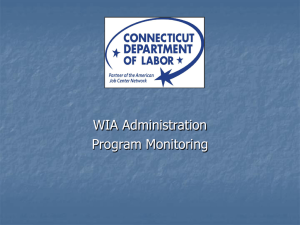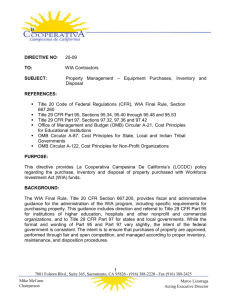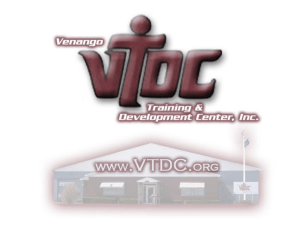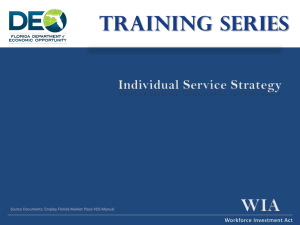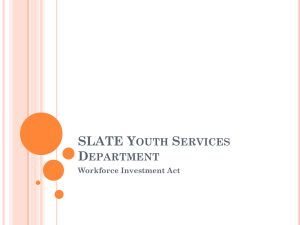DEPARTMENT OF COMMERCE
advertisement
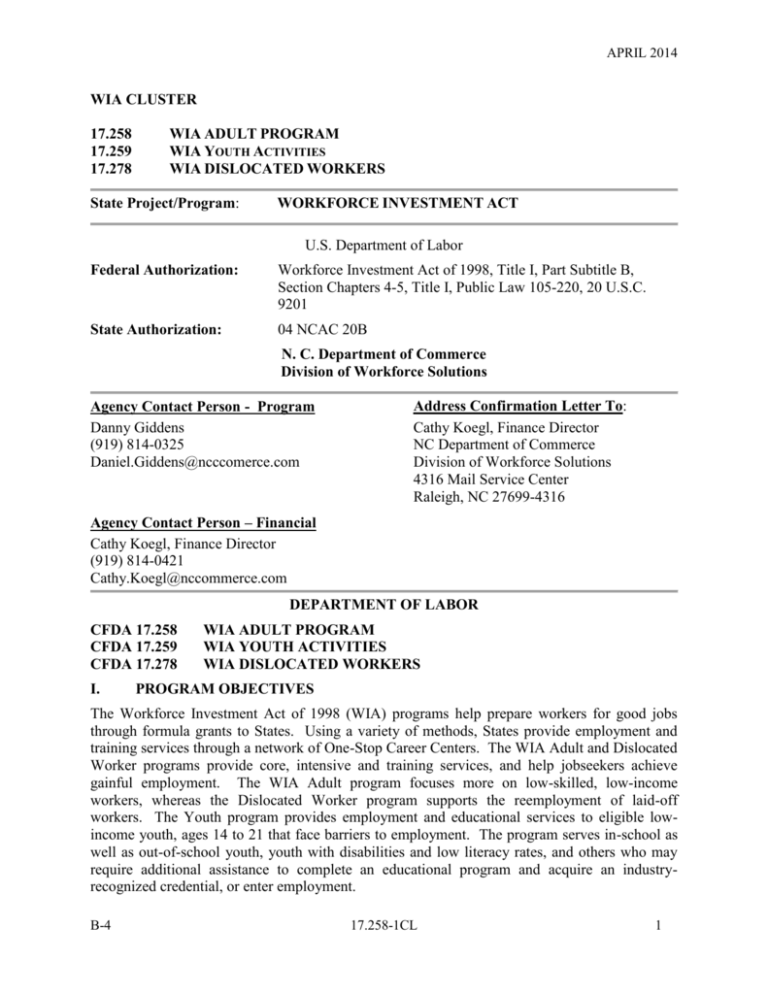
APRIL 2014 WIA CLUSTER 17.258 17.259 17.278 WIA ADULT PROGRAM WIA YOUTH ACTIVITIES WIA DISLOCATED WORKERS State Project/Program: WORKFORCE INVESTMENT ACT U.S. Department of Labor Federal Authorization: Workforce Investment Act of 1998, Title I, Part Subtitle B, Section Chapters 4-5, Title I, Public Law 105-220, 20 U.S.C. 9201 State Authorization: 04 NCAC 20B N. C. Department of Commerce Division of Workforce Solutions Agency Contact Person - Program Danny Giddens (919) 814-0325 Daniel.Giddens@ncccomerce.com Address Confirmation Letter To: Cathy Koegl, Finance Director NC Department of Commerce Division of Workforce Solutions 4316 Mail Service Center Raleigh, NC 27699-4316 Agency Contact Person – Financial Cathy Koegl, Finance Director (919) 814-0421 Cathy.Koegl@nccommerce.com DEPARTMENT OF LABOR CFDA 17.258 CFDA 17.259 CFDA 17.278 I. WIA ADULT PROGRAM WIA YOUTH ACTIVITIES WIA DISLOCATED WORKERS PROGRAM OBJECTIVES The Workforce Investment Act of 1998 (WIA) programs help prepare workers for good jobs through formula grants to States. Using a variety of methods, States provide employment and training services through a network of One-Stop Career Centers. The WIA Adult and Dislocated Worker programs provide core, intensive and training services, and help jobseekers achieve gainful employment. The WIA Adult program focuses more on low-skilled, low-income workers, whereas the Dislocated Worker program supports the reemployment of laid-off workers. The Youth program provides employment and educational services to eligible lowincome youth, ages 14 to 21 that face barriers to employment. The program serves in-school as well as out-of-school youth, youth with disabilities and low literacy rates, and others who may require additional assistance to complete an educational program and acquire an industryrecognized credential, or enter employment. B-4 17.258-1CL 1 WIA CLUSTER II. PROGRAM PROCEDURES Subtitle B Statewide and Local Workforce Investment Programs This provides the framework for delivery of workforce investment activities at the State and local levels to individuals who need those services, including job seekers, dislocated workers, youth, incumbent workers, new entrants to the workforce, veterans, persons with disabilities, and employers. Each State’s Governor is required to establish a State Board; develop a State Workforce Investment Plan (WIA section 112; 29 USC 2822); designate local workforce investment areas; and oversee the creation of Local Boards and One-Stop service delivery systems in the State. The Local Workforce Investment Board (Local Board) is appointed by the chief elected official in each local area in accordance with State criteria established under WIA section 117(b), and is certified by the Governor every two years. The Local Board, in cooperation with the chief elected official, appoints a youth council as a subgroup of the Local Board and coordinates workforce and youth plans and activities with the youth council, in accordance with WIA section 117(h). With the chief elected official, the Local Board sets policy for the portion of the Statewide workforce investment system within the local area (29 USC 2832). Each Local Board, in partnership with the appropriate chief elected officials, develops and submits a comprehensive five-year plan to the Governor which identifies and describes certain policies, procedures and local activities that are carried out in the local area, and that is consistent with the State Workforce Investment Plan and WIA section 118(b) (29 USC 2833(b)). The plan must include a description of the One-Stop delivery system to be established or designated in the local area, including: a copy of the local Memorandums of Understanding (MOU) between the Local Board and each of the One-Stop partners describing the operation of the local One-Stop delivery system; identification of the One-Stop operator or entity responsible for the disbursal of grant funds; and a description of the competitive process to be used to award grants and contracts for activities carried out under this subtitle I of WIA, including the process to be used to procure training services that are made as exceptions to the Individual Training Account process (WIA section 134(d)(4)(G); 29 USC 2864). The agreement (20 CFR section 662.400(c)) between the Local Board and the One-Stop operator shall specify the operator’s role. That role may range between simply coordinating service providers within the center, to being the primary provider of services within the center, to coordinating activities throughout the local One-Stop system. The types of entities that may be selected to be the One-Stop operator include: a postsecondary educational institution; an Employment Service agency established under the Wagner-Peyser Act on behalf of the local office of the agency; a private, non-profit organization (including a community-based organization); a private for-profit entity; a government agency; and another interested organization or entity. The One-Stop operator may be a single entity or a consortium of entities and may operate one or more One-Stop centers. In addition, there may be more than one OneStop operator in a local area. The following Federal programs are required by WIA section 121(b)(1) to be partners in the local One-Stop system: programs authorized under Title I of WIA; public labor exchange B-4 17.258-1CL 2 WIA CLUSTER programs authorized under the Wagner-Peyser Act (29 USC 49 et seq.); adult education and literacy activities authorized under title II of WIA; programs authorized under parts A and B of title I of the Rehabilitation Act (29 USC 720 et seq.); welfare-to-work programs authorized under sec. 403(a)(5) of the Social Security Act (42 USC 603(a)(5) et seq.); senior community service employment activities authorized under title V of the Older Americans Act of 1965 (42 USC 3056 et seq.); postsecondary vocational education activities under the Carl D. Perkins Vocational and Applied Technology Education Act (20 USC 2301 et seq.); Trade Adjustment Assistance and NAFTA Transitional Adjustment Assistance activities authorized under chapter 2 of title II of the Trade Act of 1974 (19 USC 2271 et seq.); activities authorized under chapter 41 of title 38, USC (local veterans’ employment representatives and disabled veterans outreach programs); employment and training activities carried out under the Community Services Block Grant (42 USC 9901 et seq.); employment and training activities carried out by the Department of Housing and Urban Development (WIA sec. 121(b)(1)(B)(xi)); and programs authorized under State unemployment compensation laws (in accordance with applicable Federal law). WIA also provides that other entities that carry out human resource programs, including Federal, State, or local programs and programs in the private sector, may serve as additional partners in the One-Stop system if the Local Board and chief elected official(s) approve the entity’s participation. Additional partners may include: Temporary Assistance for Needy Families programs authorized under part A of title IV of the Social Security Act (42 USC 601 et seq.); employment and training programs authorized under section 6(d)(4) of the Food Stamp Act of 1977 (7 USC 2015(d)(4)) and work programs authorized under section 6(o) of the Food Stamp Act of 1977 (7 USC 2015(o)); programs authorized under the National and Community Service Act of 1990 (42 USC 12501 et seq.); and other appropriate Federal, State or local programs, including programs related to transportation and housing and programs in the private sector (WIA sec. 121(b)(2); 29 USC 2841(b)(2)). All required programs must: make available to participants through the One-Stop delivery system the core services that are applicable to the partner’s programs (WIA sec. 121(b)(1)(A)); use a portion of funds made available to the partner’s program, to the extent not inconsistent with the Federal law authorizing the partner’s program, to create and maintain the One-Stop delivery system and provide core services (WIA sec. 134(d)(1)(B)); enter into a memorandum of understanding (MOU) with the Local Board relating to the operation of the One-Stop system, including a description of services, how the cost of the identified services and operating costs of the system will be funded, and methods for referrals (WIA sec. 121(c)); participate in the operation of the One-Stop system consistent with the terms of the MOU and requirements of authorizing laws (WIA sec. 121(b)(1)(B)); and provide representation on the Local Workforce Investment Board (WIA sec. 117(b)(2)(A)(vi); 20 CFR section 662.230). The applicable core services may be made available by the provision of appropriate technology at the comprehensive One-Stop center, by co-locating personnel at the center, cross-training of staff, or through a cost-reimbursement or other agreement between service providers at the comprehensive One-Stop center and the partner programs, as described in the State Workforce Investment Plan and the local MOU. Core services may also be made available through the networks of affiliated sites and One-Stop partners described in WIA section 134(c)(2) (20 CFR section 662.250). B-4 17.258-1CL 3 WIA CLUSTER The workforce investment system established under WIA emphasizes informed customer choice, system performance, and continuous improvement. The eligible provider process is part of the strategy for achieving these goals. A Local Board may not itself provide training services to adults and dislocated workers unless it receives a waiver from the Governor and meets the requirements of WIA section 117(f)(1) (29 USC 2832(f)(1)). Instead, Local Boards, in partnership with the State, identify training providers and programs whose performance qualifies them to receive WIA funds to train adults and dislocated workers. After receiving core and intensive services and in consultation with case managers, eligible participants who need training use the list of these eligible providers, which contains performance and cost information on eligible providers, to make an informed choice (20 CFR section 663.440). Individual Training Accounts (ITAs) are established for eligible individuals to finance training through these eligible providers. Payments from ITAs may be made in a variety of ways, including the electronic transfer of funds through financial institutions, vouchers, or other appropriate methods. Payments may also be made through payment of a portion of the costs at different points in the training course (20 CFR section 663.410). Exceptions to the use of ITAs are permissible only where the services provided are for on-the-job or customized training; where the Local Board determines that there is an insufficient number of eligible providers available locally; or in the case of programs of demonstrated effectiveness serving participant populations which face multiple barriers to employment (20 CFR section 663.430). The ability of providers to successfully perform, the procedures State and Local Boards use to establish training provider eligibility, and the degree to which information, including performance information, on those providers is made available to customers eligible for training services, are key factors affecting the successful implementation of the Statewide workforce investment system (20 CFR section 663.500). Source of Governing Requirements The WIA program is authorized by: Title I of the Workforce Investment Act of 1998 (Pub. L. No. 105-220, 112 Stat. 936-1059; 29 USC 2811 et seq.). Additional funding and associated requirements are included in Title VIII of the American Recovery and Reinvestment Act of 2009 (Pub. L. No. 111-5) (ARRA). The regulations are at 20 CFR parts 660-671. Availability of Other Program Information Additional information on programs authorized under the Workforce Investment Act can be found on the Internet at http://www.doleta.gov/programs/adult_program.cfm#wia. The Planning and Policy Guidance section is a particularly useful source of information on compliance issues. III. COMPLIANCE REQUIREMENTS In developing the audit procedures to test compliance with the requirements for a Federal program, the auditor should first look to Part 2, Matrix of Compliance Requirements, to identify which of the 14 types of compliance requirements described in Part 3 are applicable, and then look to Parts 3 and 4 for the details of the requirements. A. B-4 Activities Allowed or Unallowed 17.258-1CL 4 WIA CLUSTER 1. 2. Waivers and Work-Flex a. The Secretary of Labor may waive statutory or regulatory requirements of the adult and youth provisions of the Act and of the Wagner-Peyser Act (29 USC 2939(i)(4); 20 CFR sections 661.400 through .420). b. Under an approved Workforce Flexibility plan, a Governor may be granted authority to approve requests for waivers of statutory or regulatory provisions of Title I submitted by local workforce areas (29 USC 2942; 20 CFR sections 661.430 and .440)). Statewide Activities Statewide workforce investment activities include (20 CFR sections 665.200 and .210): B-4 a. State administration of the adult, dislocated worker, and youth workforce investment activities. b. Providing capacity building and technical assistance to local areas, including Local Boards, One-Stop operators, One-Stop partners, and eligible providers. c. Conducting research and demonstrations. d. Establishing and implementing innovative incumbent worker training programs, which may include an employer loan program to assist in skills upgrading, and programs targeted to empowerment zones and enterprise communities. e. Providing support to local areas for the identification of eligible training providers. f. Implementing innovative programs for displaced homemakers, and programs to increase the number of individuals trained for and placed in non-traditional employment. g. Carrying out adult and dislocated worker employment and training activities as the State determines are necessary to assist local areas in carrying out local employment and training activities. h. Carrying out youth activities Statewide. i. Preparing the annual performance progress report and submitting it to the Secretary of Labor, as described in 20 CFR section 667.300(e). j. Carrying out required rapid response activities. 17.258-1CL 5 WIA CLUSTER k. 3. B-4 Disseminating: (1) The State list of eligible providers of training services, for adults and dislocated workers. (2) Information identifying eligible providers of on-the-job training and customized training. (3) Performance and program cost information about these providers. (4) A list of eligible providers of youth activities. l. Conducting evaluations, under WIA section 136(e), of workforce investment activities for adults, dislocated workers and youth, in order to establish and promote methods for continuously improving such activities to achieve high-level performance within, and high-level outcomes from, the Statewide workforce investment system. m. Providing incentive grants. n. Providing technical assistance to local areas that fail to meet local performance measures. o. Assisting in the establishment and operation of One-Stop delivery systems, in accordance with the strategy described in the State Workforce Investment Plan. p. Providing additional assistance to local areas that have high concentrations of eligible youth. q. Operating a fiscal and management accountability information system. Local Activities – Subtitle B Adult and Dislocated Worker Programs a. Funds may be used at the local level to pay for core One-Stop system costs as well as for intensive services and training services for program participants. b. Core Services – The following are core services (20 CFR section 662.240): (1) Eligibility determination for WIA services. (2) Outreach, intake, and orientation to available information and services. (3) Initial assessment of skill levels, aptitudes, abilities and supportive services needs. 17.258-1CL 6 WIA CLUSTER c. d. B-4 (4) Career counseling. (5) Job search and placement assistance. (6) Provision of employment statistics and job information. (7) Provision of performance information on eligible providers of training services, youth activities, and adult education. (8) Provision of information on local area performance. (9) Provision of information on availability of supportive services. (10) Provision of information regarding filing Unemployment Insurance (UI) claims. (11) Assistance in establishing eligibility for welfare to work activities and programs of financial assistance for training and education programs. (12) Follow-up services including counseling for individual placed into unsubsidized employment for at least 12 months following placement (20 CFR section 663.150). Intensive Services – The following are intensive services (29 USC 2864(d)(3); 20 CFR section 663.200): (1) Specialized assessments including diagnostic testing, in-depth interviewing, and evaluation. (2) Development of employment plan. (3) Group counseling. (4) Individual counseling and career planning. (5) Case management. (6) Pre-vocational services, including workplace behavior skills training. Training Services – The following are training services (29 USC 2864(d)(4); 20 CFR section 663.300): (1) Occupational training. (2) On-the-Job-Training (OJT) (Employers may be reimbursed up to 50 percent of the wage rate of an OJT participant for the extraordinary costs of providing the training and additional 17.258-1CL 7 WIA CLUSTER supervision related to the OJT. The employer is not required to document its extraordinary costs (20 CFR section 663.710)). e. 4. Skill upgrading. (4) Entrepreneurial training. (5) Job readiness training. (6) Adult literacy. (7) Customized training (Customized training is designed to meet the special needs of an employer. Such employers are required to pay at least fifty percent of the training (20 CFR section 663.715)). At the discretion of the State and Local Boards the following services may be provided (29 USC 2864(e)): (1) Customized screening and referral. (2) Supportive services, including needs related payments. Local Activities – Subtitle B Youth Activities a. B-4 (3) Youth activities can provide a wide array of activities relating to employment, education and youth development. With the exception of the design framework component (e.g., services for intake, objective assessment, and the development of individual service strategy), these activities must be obtained by grant or contract with a service provider. The activities include but are not limited to the following (29 USC 2843 and 2854(c)(2); 20 CFR sections 664.405(a)(4) and .410): (1) Tutoring, study skills training, and instruction leading to completion of secondary school, including dropout prevention strategies. (2) Alternative secondary school services. (3) Summer employment opportunities that are directly linked to academic and occupational learning. (4) Paid and unpaid work experience, including internships and job shadowing. (5) Occupational skills training. (6) Leadership development opportunities, including community service and peer-centered activities encouraging responsibility and other positive social behaviors. 17.258-1CL 8 WIA CLUSTER b. 5. (7) Supportive services. (8) Adult mentoring for a period of participation and a subsequent period, for a total of not less than 12 months. (9) Follow-up services. (10) Comprehensive guidance and counseling, including drug and alcohol abuse counseling and referral. Funds allocated to a local area for eligible youth shall be used for programs that (20 CFR section 664.405): (1) Objectively assess academic levels, occupational skills levels, service needs (i.e., occupational, prior work experience, employability, interests, aptitudes), and supportive service needs of each participant; (2) Develop service strategies that identify an employment goals, achievement objectives, and the appropriate services needed to achieve the goals and objectives for each participant; and (3) Provide post-secondary education preparation, linkages between academic and occupational learning, preparation for unsubsidized employment opportunities, and effective connections to intermediaries with strong links to the job market and local and regional employers. Activities Unallowed – All WIA Programs WIA title I funds may not be used for the following activities: a. B-4 Construction or purchase of facilities or buildings (20 CFR section 667.260), with the following exceptions: (1) Providing physical and programmatic accessibility and reasonable accommodation, as required under section 504 of the Rehabilitation Act of 1973, as amended, and the Americans with Disabilities Act of 1990, as amended (20 CFR section 667.260(a)). (2) Repairs, renovations, alterations and capital improvements of SESA real property and JTPA-owned property which is transferred to WIA title I programs (20 CFR section 667.260(b)). (3) Disaster relief employment on projects for demolition, cleaning, repair, renovation, and reconstruction of damaged and destroyed structures, facilities, and lands located within a disaster area (WIA section173(d); 29 USC 2918(d); 20 CFR section 667.260(d)). 17.258-1CL 9 WIA CLUSTER 6. b. Employment-generating activities, economic development activities, investment in revolving loan funds, capitalization of businesses, investment in contract bidding resource centers, and similar activities, unless they directly relate to training for eligible individuals. Employer outreach and job development activities are considered directly related to training for eligible individuals (WIA section 181(e); 29 USC 2931(e); 20 CFR section 667.262). c. The employment or training of participants in sectarian activities. Participants shall not be employed in the construction, operation, or maintenance of a facility that is or will be used for sectarian instruction or as a place for religious worship. However, WIA funds may be used for the maintenance of a facility that is not primarily or inherently devoted to sectarian instruction or religious worship if the organization operating the facility is part of a program or activity providing services to WIA participants. (WIA section 188(a)(3); 29 USC 2938(a)(3); 20 CFR section 667.266). d. Encouraging or inducing the relocation of a business or part of a business from any location in the United States if the relocation results in any employee losing his or her job at the original location (20 CFR section 667.268). e. Providing customized training, skill training, or on-the-job training or company specific assessments of job applicants or employees of a business or a part of a business that has relocated from any location in the United States, until the company has operated at that location for 120 days, if the relocation resulted in any employee losing his or her job at the original location (20 CFR section 667.268(a)). f. Paying the wages of incumbent employees during their participation in economic development activities provided through a Statewide workforce investment system (WIA section 181(b)(1); 29 USC 2931(b)(1); 20 CFR section 667.264(a)(1)). g. Public service employment, except to provide disaster relief employment, as specifically authorized in section 173(d) of WIA (WIA sec. 195(10); 29 USC 2945(10); 20 CFR section 667.264(a)(2)). Activities Unallowed – All Subtitle B Statewide and Local Programs Funds available to States and local areas under subtitle B may not be used for foreign travel (29 USC 2931(e)). B. Allowable Costs/Cost Principles 1. B-4 One-Stop Centers 17.258-1CL 10 WIA CLUSTER The Department of Labor (DOL), in a collaborative effort with other Federal agencies, published in the Federal Register dated May 31, 2001 (66 FR 29637) a notice that provides guidance on resource sharing methodologies for the shared costs of a One-Stop service delivery system. 2. All Subtitle B Statewide and Local Programs For those selected items of cost requiring prior approval, the authority to grant or deny approval is delegated to the Governor for youth, adult, and dislocated worker programs (20 CFR section 667.200(c)). E. Eligibility 1. Eligibility for Individuals a. All Programs Selective Service – No participant may be in violation of section 3 of the Military Selective Service Act (50 USC App. 453) by not presenting and submitting to registration under that Act (29 USC 2939(h)). b. B-4 All Subtitle B Statewide and Local Programs (1) An adult must be 18 years of age or older. (2) A dislocated worker means an individual who meets the definition in 29 USC 2801(9). (3) A dislocated homemaker means an individual who meets the definition in 29 USC 2801(10). (4) Before receiving training services, an adult or dislocated worker must have received at least one intensive service, been determined to be unable to obtain or retain employment through intensive services, and met all of the following requirements (20 CFR sections 663.240 and 663.310): (a) Had an interview, evaluation, or assessment and determined to be in need of training services and have the skills and qualifications to successfully complete the selected training program. (b) Selected a training service linked to the employment opportunities. (c) Was unable to obtain grant assistance from other sources, including other Federal programs, to pay the costs of the training. 17.258-1CL 11 WIA CLUSTER c. Subtitle B Youth Activities A person is eligible to receive services under Youth Activities if they are between the ages of 14 and 21 at the time of enrollment (20 CFR section 664.200) and demonstrate at least one of the following barriers to employment: deficient in basic literacy skills; a school dropout; homeless; a runaway; a foster child; pregnant or parenting; offender; or an individual who requires additional assistance to complete an educational program, or to secure and hold employment (20 CFR sections 664.200, .205, and .210). Age eligibility for youth services funded by ARRA is increased from 21 to 24 years of age. (ARRA Title VIII(2), 123 Stat 173). See III.G.3.d.(2), “Matching, Level of Effort, Earmarking – Earmarking,” for the requirement that at least 95 percent of eligible youth participants be disadvantaged low-income youth as defined in 29 USC 2801(25). F. 2. Eligibility for Group of Individuals or Area of Service Delivery – Not Applicable 3. Eligibility for Subrecipients – Not Applicable Equipment and Real Property Management Recipients and subrecipients may permit employers to use WIA-funded, local area services, facilities, or equipment on a fee-for-service basis, to provide employment and training activities to incumbent workers if this does not interfere with utilization by eligible participants and the income generated from such fees is treated as program income (29 USC 2945(13); 20 CFR section 667.200(a)(8)). G. Matching, Level of Effort, Earmarking 1. Matching – Not Applicable 2 Level of Effort – Not Applicable 3. Earmarking Subtitle B Statewide and Local Programs a. Statewide Activities (1) B-4 State Reserve – A State may reserve up to 15 percent of the amounts allotted for Adult, Dislocated Worker, and Youth Activities. The amounts reserved may be combined and expended on activities described in 20 CFR sections 665.200 and .210 without regard to funding source (20 CFR section 667.130). 17.258-1CL 12 WIA CLUSTER (2) b. Administrative Cost Limits – A State may spend up to five percent of the amount allotted for the State’s administrative costs (i.e., onethird of the 15 percent State Reserve described in the preceding paragraph) (20 CFR section 667.210). The term “administrative costs” is defined at 20 CFR section 667.220. The funds provided for administrative costs by one of the three funding sources (Adult, Dislocated Worker, and Youth Activities) can be used for administrative costs of the other two sources. Dislocated Worker Activities – Rapid Response Statewide Rapid Response – The State must reserve for rapid response activities a portion of funds, up to 25 percent, allotted for dislocated workers. The funds are used to plan and deliver services to enable dislocated workers to transition to new employment as quickly as possible, following either a permanent closure or mass layoff, or a natural or other disaster resulting in a mass job relocation (20 CFR section 667.130(b)). c. Local Areas Administrative Cost Limits – A local area may expend no more than ten percent of the Adult, Dislocated Worker, and Youth Activities funds allocated to the local area under sections 128(b) and 133(b) of the Act for administrative costs. The funds provided for administrative costs by one of the three fund sources (Adult, Dislocated Worker, Youth Activities) can be used for administrative costs of the other two sources (20 CFR section 667.210(a)(2)). d. e. Youth Activities (1) Out-of School Youth – Thirty percent of the Youth Activity funds allocated to the local areas, except for the local area expenditures for administration, must be used to provide services to out-ofschool youth (20 CFR section 664.320). (2) Low-Income Youth – A minimum of 95 percent of eligible participants in Youth Activities must meet the criteria of disadvantaged low-income youth as defined in 29 USC 2801(25) (20 CFR section 664.220). Adult and Dislocated Workers Funds Transfers of Funds – Section 133(b)(4) of the WIA authorizes workforce investment areas, with the approval of the Governor, to transfer up to 20 percent of the Adult Activities funds to Dislocated Workers Activities, and up to 20 percent of Dislocated Workers Activities funds to Adult Activities. The transfer limits are 30 percent (Pub. L. No. 112-10). B-4 17.258-1CL 13 WIA CLUSTER H. Period of Availability of Federal Funds 1. Statewide Activities Funds allotted to a State for any program year are available for expenditure by the State during that program year and the two succeeding program years (29 USC 2939(g)(2); 20 CFR section 667.107(a)). 2. Local Areas Funds allocated by a State to a local area for any program year are available for expenditure only during that program year and the succeeding program year. Funds which are not expended by a local area in this two-year period must be returned to the State, which can use the funds for Statewide projects during the third program year of availability, or distribute the funds to local areas which had fully expended their allocation of funds for the same program year within the twoyear period (29 USC 2939(g)(2); 20 CFR section 667.107(b)). I. Procurement and Suspension and Debarment 1. All Subtitle B Statewide and Local Programs All procurement contracts and other transactions between Local Boards and units of State or local governments must be conducted only on a cost-reimbursement basis. No provision for profit is allowed (20 CFR section 667.200(a)(3)). 2. Subtitle B Youth Activities The Local Board for each local such area shall identify eligible providers of youth activities by awarding grants or contracts on a competitive basis, based on the recommendations of the youth council and on the criteria contained in the State plan (WIA section 123; 29 USC 2843). J. Program Income 1. B-4 The addition method is required for use on all program income earned under WIA grants. When the cost of generating program income has been charged to the program, the gross amount earned must be added to the WIA program. However, the cost of generating program income must be subtracted from the amount earned to establish the net amount of program income available for use under the grants when these costs have not been charged to the WIA program (20 CFR section 667.200(a)(5)). 17.258-1CL 14 WIA CLUSTER 2. L. WIA specifically includes as program income: (a) receipts from goods and services, including conferences; (b) funds provided to a service provider in excess of the costs associated with the services provided; and (c) interest income earned on funds received under WIA. Any excess of revenue over costs incurred for services provided by a governmental or non-profit entity must be included in program income earned (29 USC 2945(7)(B) and 20 CFR section 667.200(a)(6)). Reporting 1. 2. Financial Reporting a. SF-270, Request for Advance or Reimbursement – Not Applicable b. SF-271, Outlay Report and Request for Reimbursement for Construction Programs – Not Applicable c. SF-425, Federal Financial Report – Not Applicable d. ETA-9130, Financial Report (OMB No. 1205-0461) – All ETA grantees are required to submit quarterly financial reports for each grant award they receive. Reports are required to be prepared using the specific format and instructions for the applicable program(s); in this case, Workforce Investment Act instructions for the following: Statewide Adult; Workforce Statewide Youth; Statewide Dislocated Worker; Local Adult; Local Youth; and Local Dislocated Worker. A separate ETA 9130 is submitted for each of these categories. Reports are due 45 days after the end of the reporting quarter. Additional information can be accessed on the Internet at http://www.doleta.gov/grants/ and scroll down to the section on Financial Status Reporting. Performance Reporting ETA-9091,WIA Annual Report (OMB Number 1205-0420) – Sanctions related to State performance or failure to submit these reports timely can result in a total grant reduction of not more than five percent as provided in WIA Section 136 (g)(1)(B). This report is accessible on the Internet at: http://www.doleta.gov/Performance/reporting/ (1) B-4 WIA Tables in Annual Report – The actual performance level information in the following tables contain critical information. (a) Table B – Adult Program Results At-A-Glance (b) Table E – Dislocated Worker Program Results At-A-Glance (c) Table H – Older Youth Program Results At-A-Glance (d) Table J – Younger Youth Program Results At-A-Glance 17.258-1CL 15 WIA CLUSTER (2) Standardized Record Data (WIASRD) – The WIASRD data records contain relevant data on individual participants’ characteristics, activities and outcomes. They are submitted to DOL in support of the Tables in the Annual Report as required at WIA Section185(d). WIASRD Key Line Items – The following line items contain critical information: (a) Item 101 – Individual identifier (b) Item 601 – Employed in quarter after exit quarter (c) Item 608 – Employed in third quarter after exit quarter (d) Item 610 – Employed in fifth quarter after exit quarter Total earnings from wage records for the: (Items 612–618) 3. (e) Item 612 – Third quarter prior to registration (f) Item 613 – Third quarter prior to dislocation (g) Item 614 – Second quarter prior to registration (h) Item 615 – Second quarter prior to dislocation (i) Item 617 – Second quarter following the exit quarter (j) Item 618 – Third quarter following the exit quarter (k) Item 621 – Type of recognized education/occupational certificate/credential/diploma/degree attained (l) Item 622 – Other reasons for exit (m) Item 623 – In postsecondary education or advanced training in quarter after exit (n) Item 624 – In postsecondary education or advanced training in the third quarter after exit Special Reporting Subtitle B Youth Activities A new supplemental monthly reporting form, (ETA-9149, OMB Control Number 1205-0474) separate from current data collection instruments, is required to track youth served with Recovery Act funds (ARRA Title VIII (2)). B-4 17.258-1CL 16 WIA CLUSTER M. 4. Section 1512 ARRA Reporting – Applicable 5. Subaward Reporting under the Transparency Act – Applicable (non-ARRA funding only) Subrecipient Monitoring 1. 2. Recipients and Subrecipients a. Each recipient and subrecipient must conduct regular oversight and monitoring of its WIA activities and those of its subrecipients and contractors in order to determine whether or not there is compliance with provisions of the Act and applicable laws and regulations and provide technical assistance as necessary and appropriate (20 CFR section 667.400(c)). b. Commercial organizations which are subrecipients under WIA title I and which expend more than the minimum level specified in OMB Circular A-133 must have either an organization-wide audit conducted in accordance with OMB Circular A-133 or a program specific financial and compliance audit (20 CFR section 667.200(b)(2)(ii)). States a. b. B-4 Each State must have a monitoring system which: (1) Provides for annual on-site monitoring reviews of local areas’ compliance with DOL uniform administrative requirements, as required by WIA section 184(a)(4); (2) Ensures that established policies to achieve program quality and outcomes meet the Act’s objectives, including policies relating to the provision of services by One-Stop Centers, eligible providers of training services, and eligible providers of youth activities; (3) Enables the Governor to determine if subrecipients and contractors are in substantial compliance with WIA requirements; (4) Enables the Governor to determine whether a local plan will be disapproved for failure to make acceptable progress in addressing deficiencies; and (5) Enables the Governor to ensure compliance with WIA nondiscrimination and equal opportunity requirements (20 CFR section 667.410(b)). Each State must conduct an annual on-site monitoring review of each local area’s compliance with DOL uniform administrative requirements, 17.258-1CL 17 WIA CLUSTER including the appropriate administrative requirements and cost principles for subrecipients and other entities receiving WIA funds. The State must require that prompt corrective action be taken if any substantial violations are identified and must impose the sanctions provided in WIA section 184(b) and (c) if a subrecipient fails to take required corrective action. The State may issue additional requirements and instructions to subrecipients on monitoring activities (20 CFR section 667.410(b)). IV. OTHER INFORMATION CFDA 17.260, which included WIA Dislocated Worker formula grants and National Emergency Grants (NEGs), has been removed from the CFDA. The new CFDA for the WIA Dislocated Worker program is 17.278 and is included as part of the WIA Cluster. The new CFDA number for the NEG program is 17.277. For awards made on or after July 1, 2011, CFDA 17.277 should be audited under Part 7 of the Supplement and not as part of the WIA cluster. B-4 17.258-1CL 18 APRIL 2014 A-133 Compliance Supplement Native American Employment and Training 4-17.265-1 DOL
